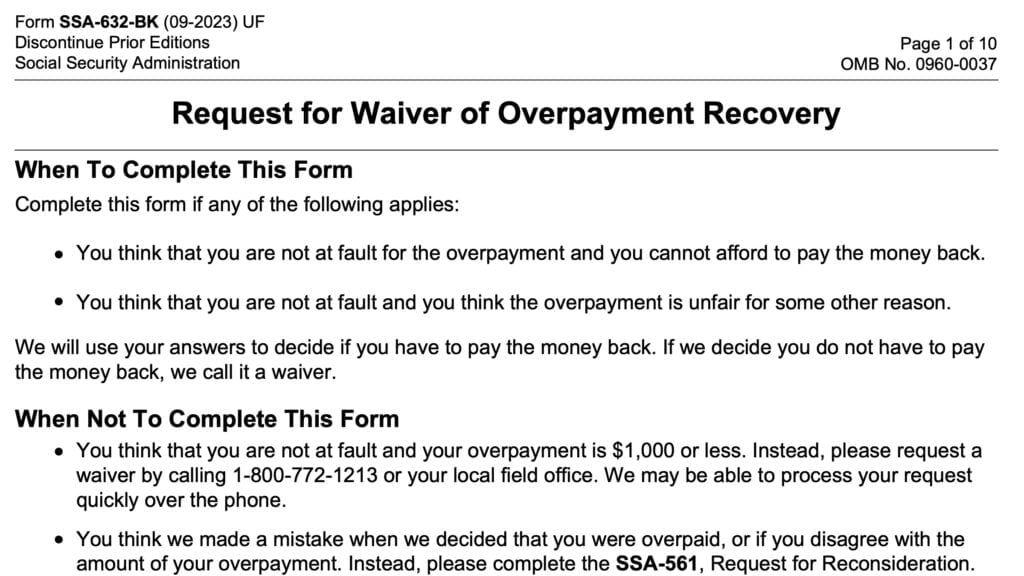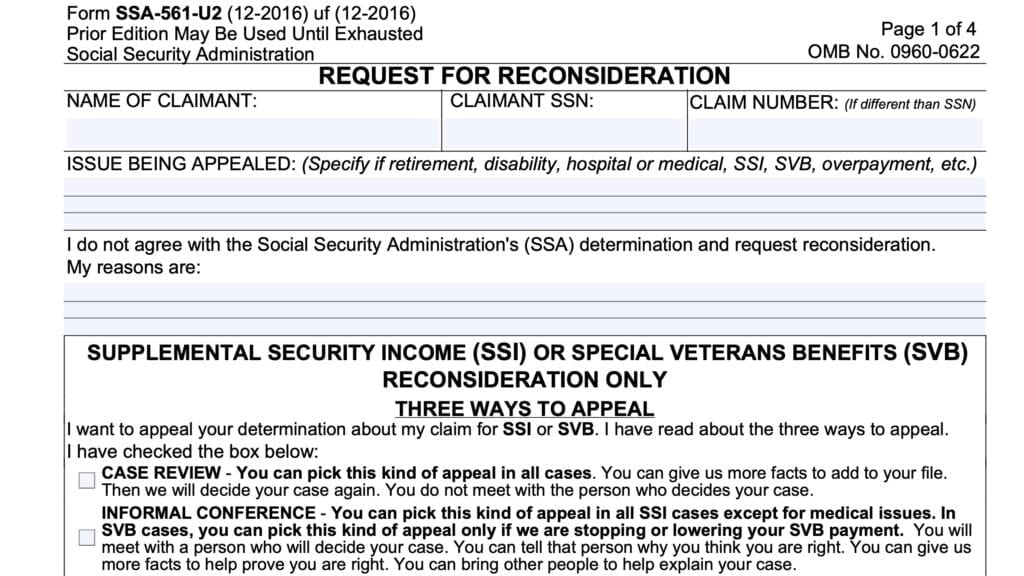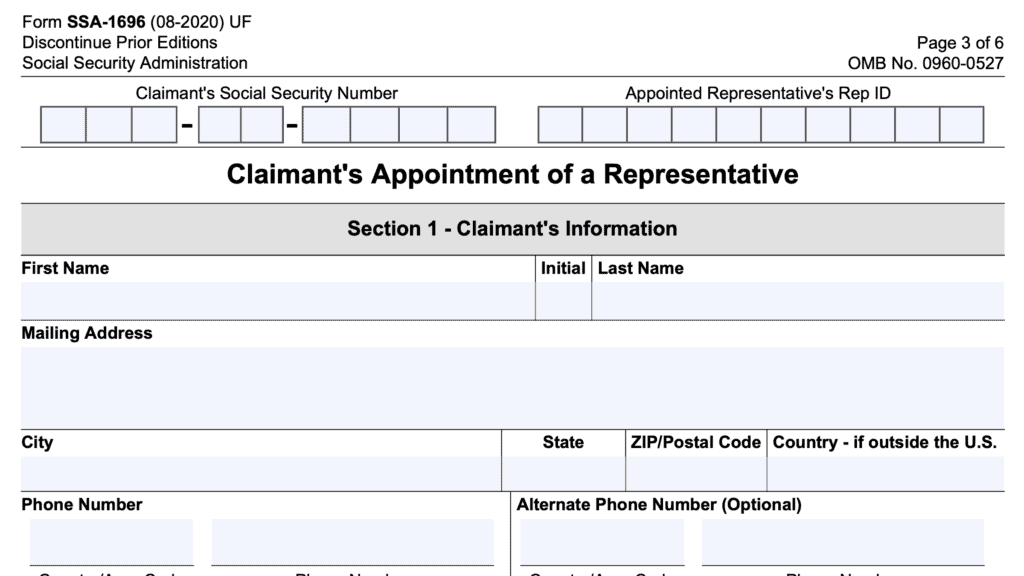Form SSA 634 Instructions
If you’ve received a notice of overpayment from the Social Security Administration, you might be able to request a waiver of overpayment recovery. Many Social Security beneficiaries may prefer to file Form SSA 634 to pay back their overpayment at a lower rate than originally requested.
In this article, we’ll walk you through everything you should know about Form SSA 634, including:
- Step by step guidance on completing the form
- How to submit your completed Form SSA 634
- Other frequently asked questions
Let’s begin with an overview of Form SSA 634, and how to complete it.
Table of contents
How do I complete Form SSA 634?
There are six sections to this Social Security form:
- Section 1: Identifying Questions
- Section 2: Assets – Things You Have and Own
- Section 3: Monthly Household Income
- Section 4: Monthly Household Expenses
- Section 5: Income and Expenses Comparison
- Section 6: Financial Expectation and Funds Availability
Let’s take a look at each section of this SSA form, beginning with Section 1.
Section 1: Identifying Questions
In Section 1, the Social Security Administration is requesting information about the requestor and the overpaid person. If they are not the same person, the SSA will want to know the nature of their relationship.
Question 1
This part asks for specifics about the person who is making this request.
Question 1A: Name, Social Security number, and claim number
In Question 1A, enter the following information regarding the overpaid person:
- Full name
- Social Security number
- Claim number, if applicable
If you are the representative payee or one of the overpaid person’s immediate family members, enter the recipient’s information, not your own. You’ll have the opportunity to discuss your relationship later on.
Question 1B: Are you the overpaid person?
Check the appropriate box.
If you are completing this form on your own behalf, you may skip to Question 2, below. Otherwise, go to Question 1C.
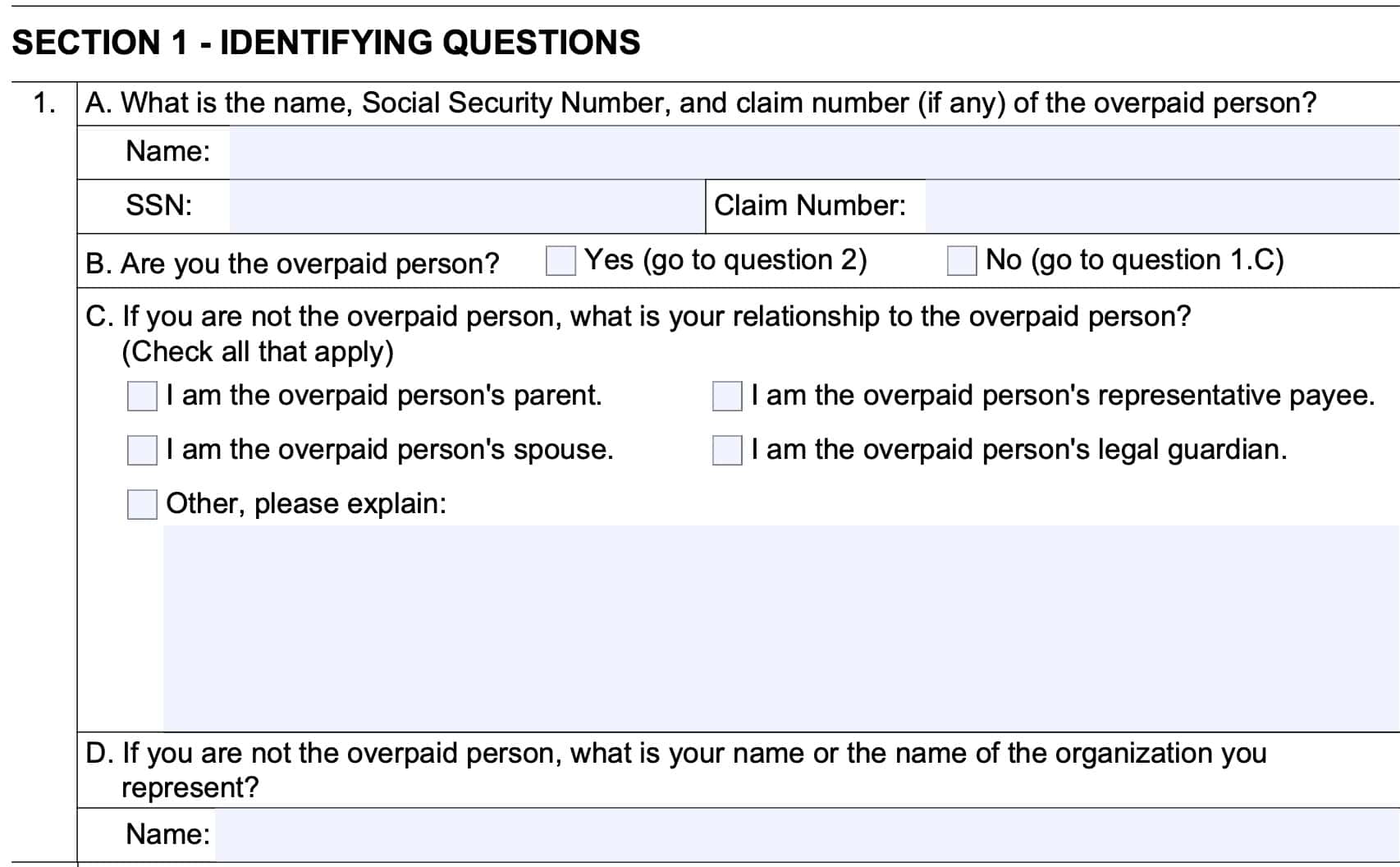
Question 1C: If you are not the overpaid person, what is your relationship to the overpaid person?
Check the appropriate box, if you are completing this request on behalf of the overpaid individual.
If you have previously filed Form SSA-11-BK as the representative payee, then check that box.
Question 1D: What is your name or the name of the organization you represent?
If you are not the overpaid recipient, then enter your name or the name of the organization you represent on this form.
Question 2
Check all of the following benefits that apply:
- Supplemental Security Income (SSI) benefits
- Temporary Assistance for Needy Families (TANF)
- Pension based on need form the Department of Veterans Affairs
- Social Security Benefits
- No benefits
Supplemental Security Income
SSI provides monthly payments to people with disabilities and older adults who have little or no income or resources.
Generally, the Social Security Administration takes additional steps to ensure that SSI recipients are able to repay the overpayment amount without losing their ability to pay their household bills.
Question 3: Amount you owe
Enter the Social Security overpayment amount in Question 3.

Question 4: Amount you can afford to pay
To answer Question 4, enter the payment amount you feel that you can repay each month.
Generally, if this amount allows you to fully repay the overpayment of benefits within 36 months, the SSA may not require you to complete Form SSA-634.
Section 2: Assets – Things You Have and Own
In Section 2, the SSA will ask questions about your current assets. This includes how much money and other financial assets you have, but also the value of certain assets, such as real estate or vehicles.
Question 5
In Question 5A, enter the amount of cash you have in your possession.
For Question 5B, enter the full amount of assets you have in accounts established at financial institutions. This may include, but is not limited to:
- Bank accounts, such as checking or savings accounts
- Money you have in online accounts, such as PayPal or Venmo
- Certificates of deposit
- Individual retirement accounts (IRAs)
- Investments, such as mutual funds, stocks, or bonds
Enter a detailed description of the financial accounts listed, to include:
- Type of account
- Name and address of the financial institution
- Name listed on the account
- Balance or value of the account
- Monthly earnings from dividend or interest income
- Account number
At the bottom of the list, add the value of each account balance and monthly income. This should leave you with a total balance of your financial assets and total income from those assts.

Question 6
In this section, we’ll calculate the total of the following assets:
- Family vehicles
- Real estate (except for your primary residence)
- Business interests, other property, and valuable items
Let’s start with vehicles.
Question 6A: Do you own more than one family vehicle?
First, indicate whether you own more than one vehicle, which is considered a requirement. If not, go to Question 6B, below.
If so, then provide the following information:
- Vehicle’s owner
- Year, make, and model of the vehicle
- Vehicle’s present value
- Outstanding loan balance, if there is one
- Main purpose of the additional vehicles
At the bottom, calculate the total value of the vehicles’ present value, and any outstanding loan balance.

Question 6B: Do you own any real estate other than where you live?
First, indicate whether you own more than one parcel of real estate, where your primary residence would be. If not, go to Question 6C, below.
If you do, then you’ll need to provide a detailed description of any real estate as follows:
- Real estate owner
- Property description
- Market value
- Loan balance, if there is one
- Monthly income (after paying monthly expenses, if used to generate income)
At the bottom, calculate the total real estate value, and any outstanding loan or mortgage balance.
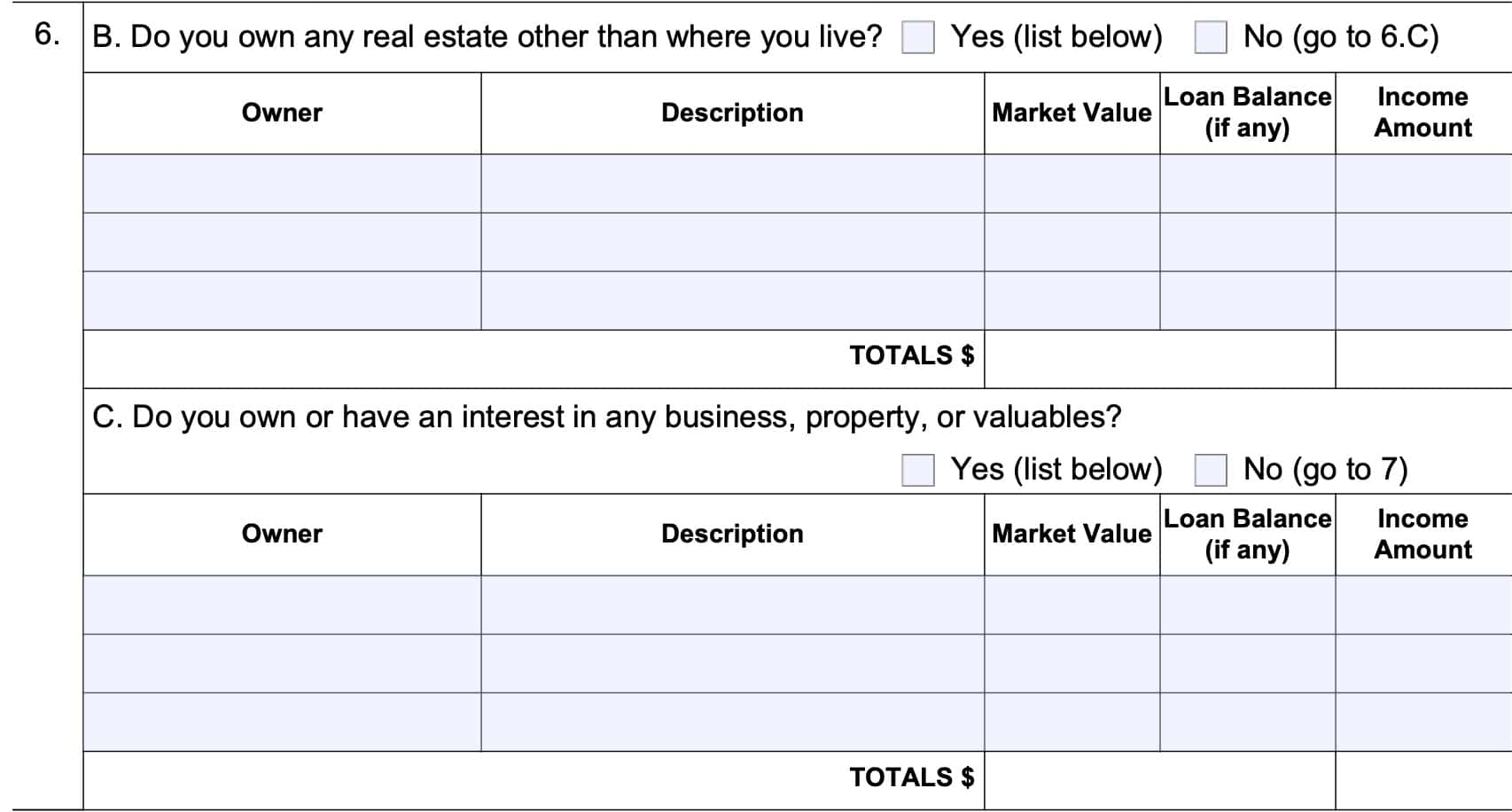
Question 6C: Do you own or have an interest in any business, property, or valuables?
Under Question 6C, indicate whether you other assets, such as business interests, other types of property, or valuables. If not, go to Question 7, below.
Otherwise, provide the following information as it pertains to each asset:
- Asset owner
- Description of the asset
- Market value
- Outstanding loan balance, if applicable
- Monthly income
At the bottom, calculate the total market value, outstanding loan balance, and income amount.
Section 3: Monthly Household Income
In this section, the SSA is asking information about monthly take hoe pay. Starting with Question 9, enter your total income as a monthly amount.
If your employer pays you weekly or every two weeks, you may be asked to convert this into a monthly payment amount. Here’s how.
Converting weekly payments into monthly amounts
There are 52 weeks per year, which means that there are not necessarily 4 weeks in each month. To arrive at a monthly income, you would multiply your weekly paycheck by 4.33 (52 weeks divided by 12 months per year).
To convert biweekly payments into monthly amounts, you would simply halve this amount, or multiply by 2.17 (26 biweekly pay periods divided by 12 months per year).
Question 7: Are you employed?
Check the appropriate box.
If you are employed, you’ll need to enter the following information:
- Employer name, address, and telephone number
- Write ‘Self’ if you are self-employed
- Pay schedule (weekly, every 2 weeks, twice a month, or monthly)
- How much you take home with each paycheck
Question 8
In this section, you’ll answer whether you receive support from another person or organization.
Question 8A: Do you receive support or contributions from any person or organization?
If you do, then answer Question 8B, below. Otherwise, go directly to Question 9.
Question 8B: Is the support received under a loan agreement?
If so, go directly to Question 9. If not, then answer Question 8C, below.
Question 8C: How much money do you receive each month?
If you receive money from an outside source that is not part of a loan agreement, then enter the monthly amount, and where the money comes from.
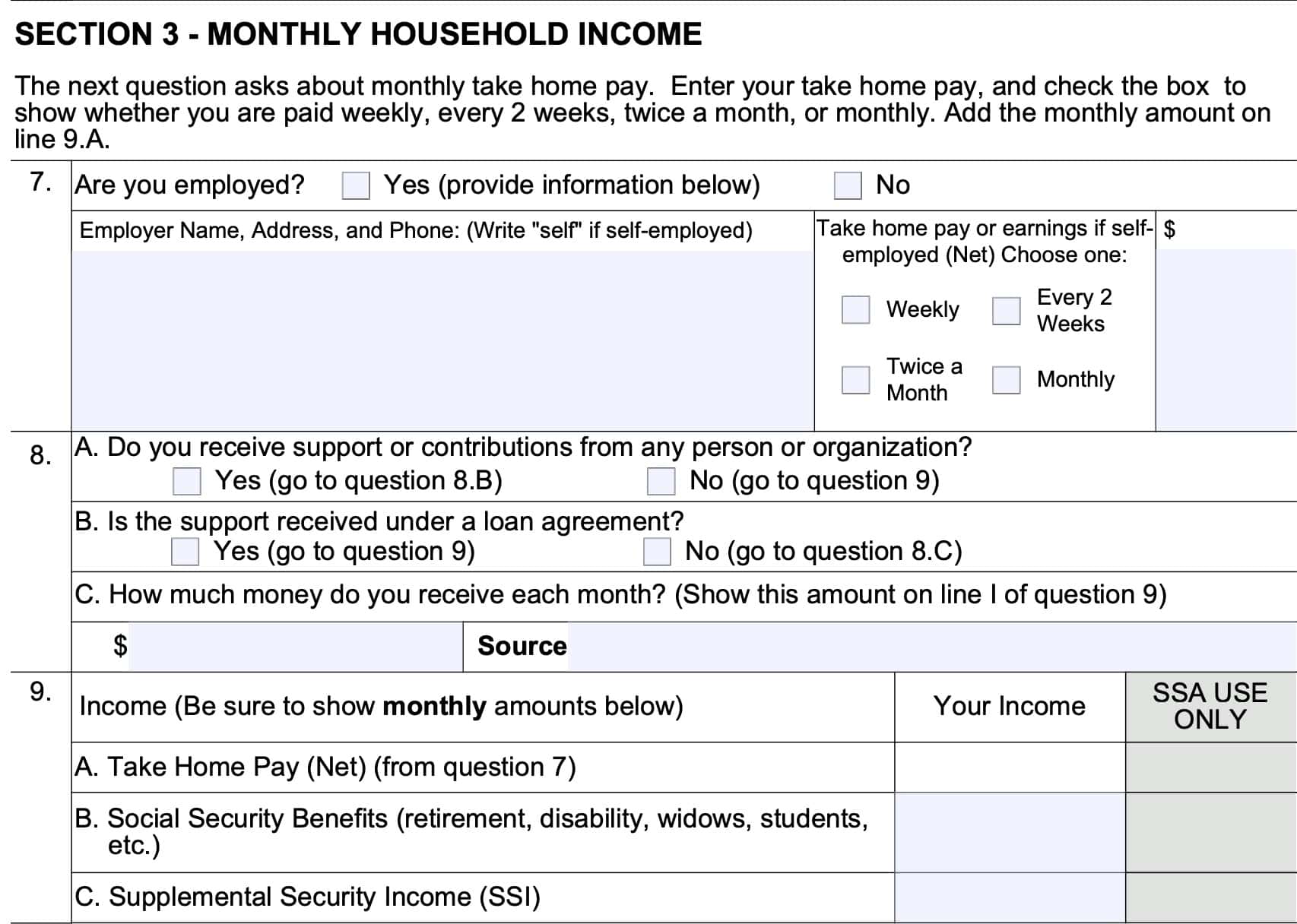
Question 9: Income
In this section, you’ll enter monthly income amounts or benefit amounts from the following sources:
- 9A: Net take home pay, as determined in Question 7
- 9B: Monthly Social Security benefits
- Includes Social Security retirement benefits, widows benefits, and disability benefits
- 9C: Supplemental Security Income (SSI)
- 9D: Pension benefits from the VA, military, civil service, or railroad
- If you receive pension benefits from more than two sources, you may need to ask for guidance from your local SSA office
- 9E: Supplemental Nutrition Assistance Program (SNAP) benefits
- 9F: Income from your real estate or business
- As outlined in Question 6B or Question 6C
- 9G: Room/board payments from a person who is not a dependent
- Could be rent payments, but explain in the remarks section provided
- 9H: Child support or alimony payments
- 9I: Other support, as indicated in Question 8C
- 9J: Income from assets listed in Question 5B
- 9K: Other income
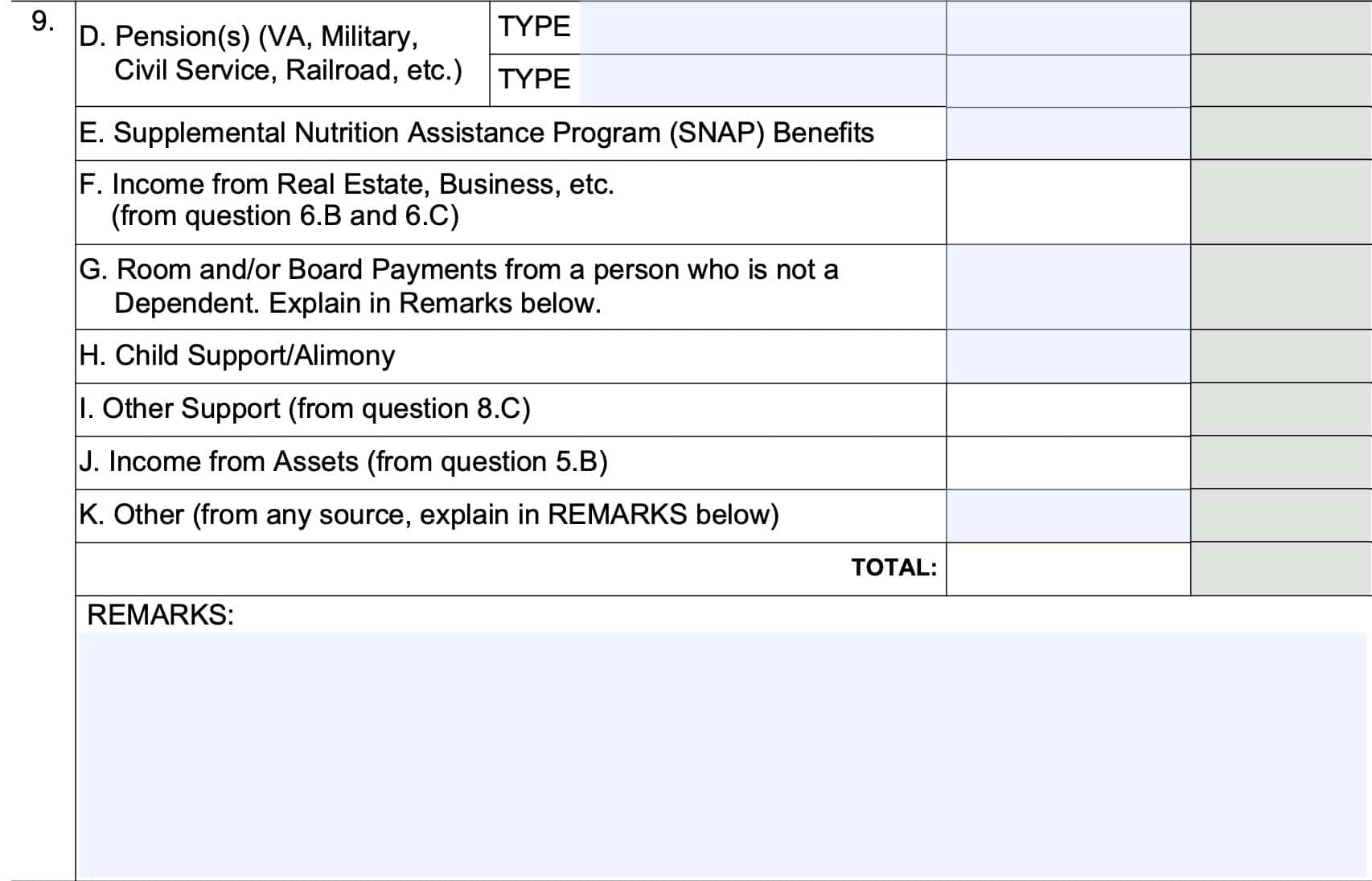
After listing all income from all sources, calculate and enter the total at the bottom. Use the remarks section as needed, or as prompted.
Section 4: Monthly Household Expenses
In Section 4, we’ll enter all household expenses. However, keep these points in mind:
- Do not list expenses withheld from your paycheck by your employer. Examples include:
- Health iinsurance
- Child support
- Alimony
- Wage garnishments
- Write monthly amounts
- Round any cents to the nearest dollar, then enter the whole dollar amount
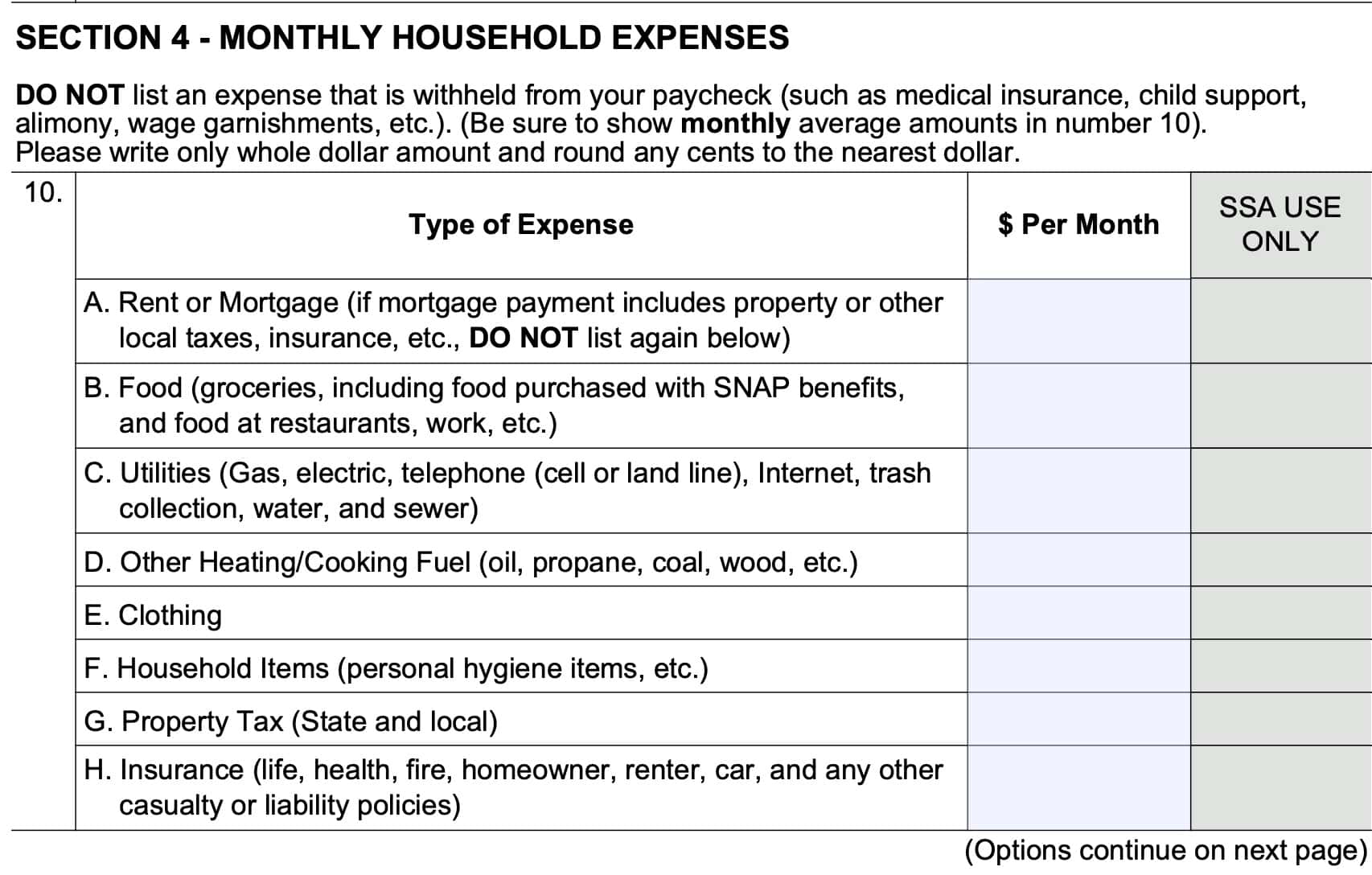
Question 10: Type of expense
In the following order, enter each type of monthly expense:
- 10A: Rent or mortgage payments
- 10B: Food, including the following:
- Groceries
- Food purchased with SNAP benefits
- Restaurant meals
- 10C: Utilities
- 10D: Heating or cooking fuel costs
- 10E: clothing
- 10F: Household items
- 10G: Property tax
- For property tax on your house, do not include if you’ve already included as part of your mortgage payment on 10A
- 10H: Insurance
- Life insurance premiums
- Medical insurance (not taken from your paycheck)
- Property and casualty insurance, such as auto insurance
- For homeowner’s insurance, do not list if this amount is
- 10I: Medical and dental expenses not covered by insurance
- 10J: Car loan or lease payments
- 10K: Vehicle expenses, such as gas and repair costs
- 10L: Other transportation, such as public transit, taxis, ride-sharing apps, as necessary for medical appointments, work, or other required travel
- 10M: Tuition and school expenses
- 10N: Court-ordered payments paid directly to the court
- 10O: Credit card payments (minimum monthly payment)
- Do not list previously listed expenses
- 10P: Other expenses not already listed
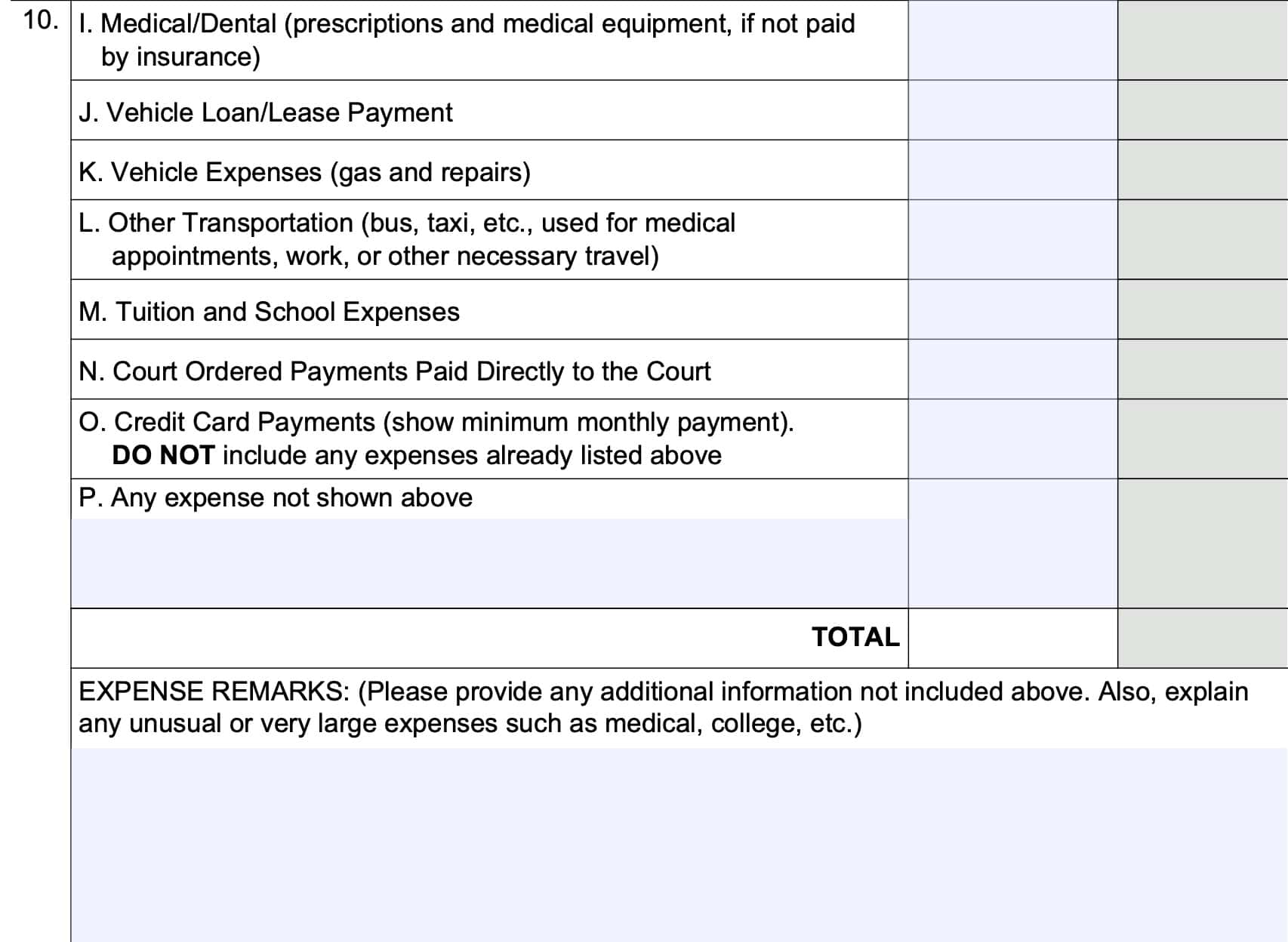
Use the remarks section to explain any unusual or large expenses.
Section 5: Income and Expenses Comparison
In this section, we’ll compare your monthly income against your monthly expenses to determine your repayment options.
Question 11
Question 11A: Monthly Income
Enter the total amount that you calculated in Question 9.
Question 11B: Monthly Expenses
Enter the total amount that you calculated in Question 10.
Question 11C: Total
Subtract the monthly expenses in Question 11B from the monthly income in Question 11A. Enter the difference here.
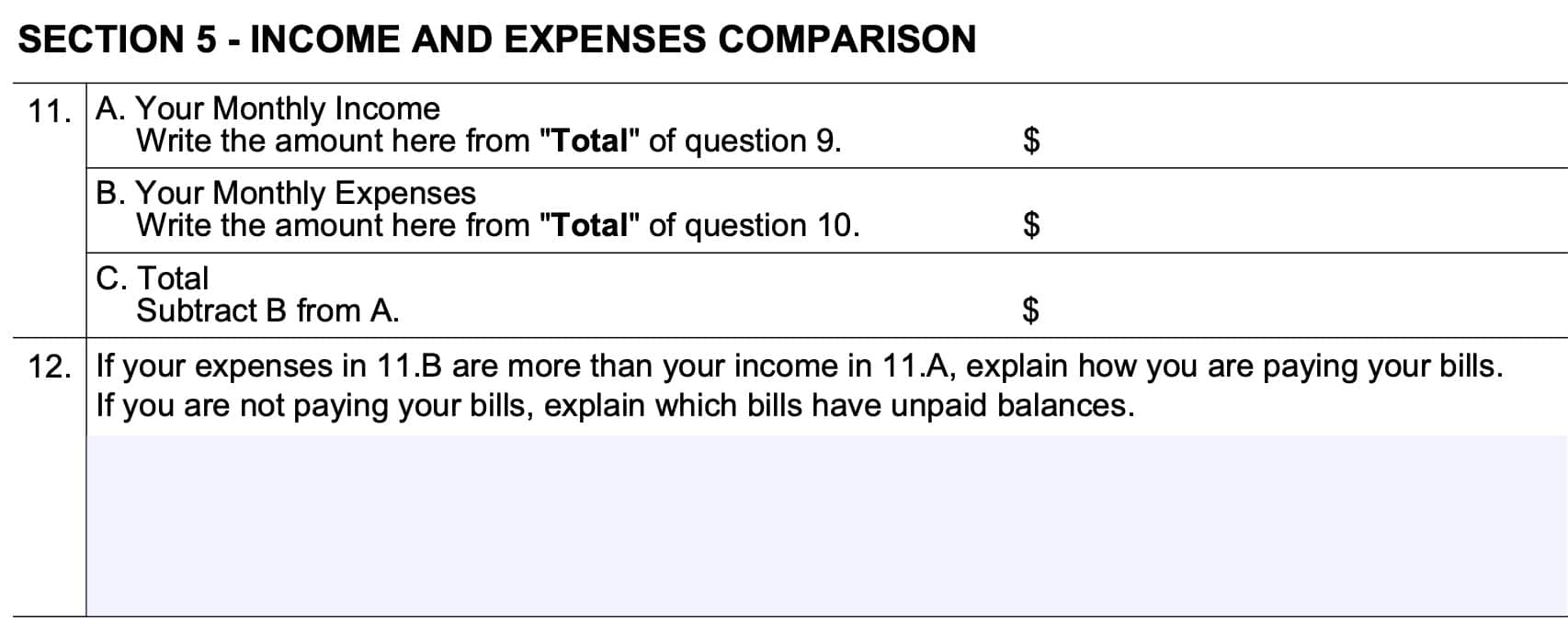
Question 12
If your monthly income exceeds your monthly expenses, you can skip this question. If your monthly expenses are more than your monthly income, then provide a written explanation of:
- How you are paying your bills, or
- Which bills have unpaid balances
Once you’re finished, proceed to Section 6, below.
Section 6: Financial Expectation and Funds Availability
In this section, you’ll answer questions related to any expected funds availability in the near future.
Question 13
Question 13A: Do you expect to receive an inheritance within the next 6 months?
If you do expect to receive an inheritance, enter details about your expected windfall in the space provided. Otherwise, go to Question 13B, below.
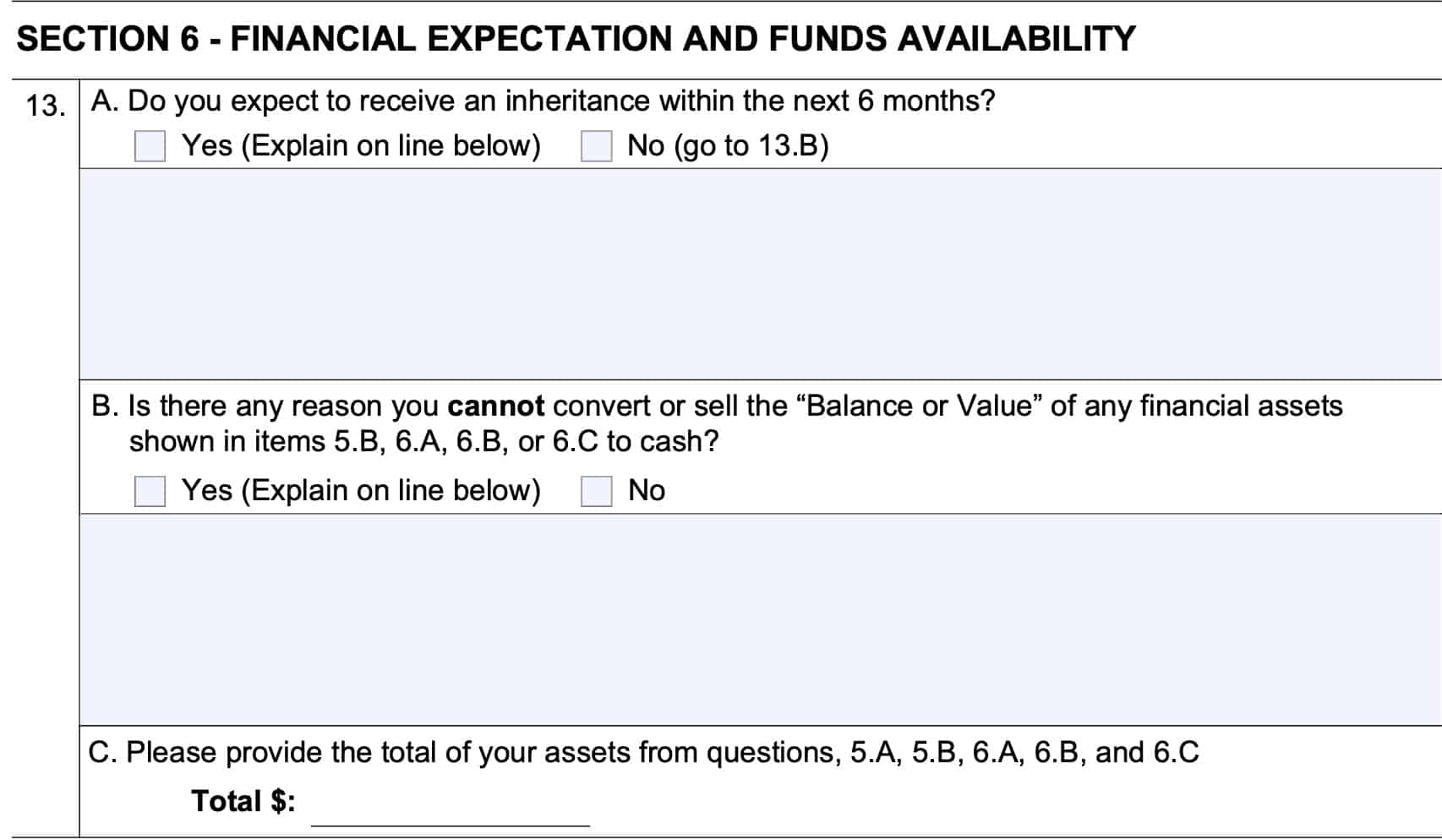
Question 13B
If there is a reason that you cannot convert or sell the balance or value of the following financial assets, then check the ‘Yes’ box and explain in the space provided:
- Question 5B: Financial account balances
- Question 6A: Excess motor vehicles
- Question 6B: Excess real estate holdings
- Question 6C: Business interests, valuables, and other assets
Otherwise, go to Question 13C.
Question 13C
If applicable, add the following values, and enter the totals here:
- Question 5A: Available cash
- Question 5B: Financial account balances
- Question 6A: Excess motor vehicles
- Question 6B: Excess real estate holdings
- Question 6C: Business interests, valuables, and other assets
Penalty clause and certification
Each application is made under the penalty of perjury. This means that intentionally submitting a false statement can be subject to civil and criminal penalties.
Once you’ve verified that the information you’re providing is complete and accurate to the best of your ability, then provide the following information:
- Date of signature
- Home phone number
- Work phone number, if applicable
- Mailing address, including city, state, and zip code
Sign the form where indicated in ink only.

For Social Security beneficiaries who sign with a mark (indicated by the letter ‘X’), two witnesses must sign this form indicating that they personally know the individual signing the form. The witnesses must also enter their mailing address.
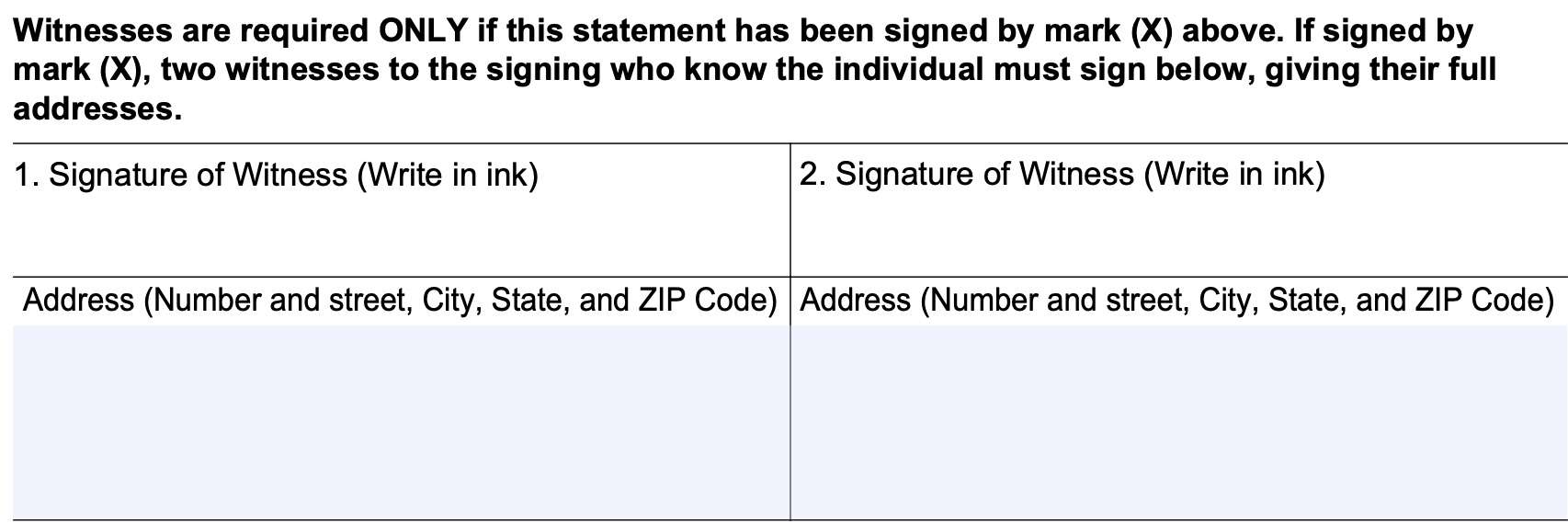
Supporting documents
The Social Security Administration will expect you to provide supporting documentation as evidence of the statements on your completed Form SSA 634. This could include supporting documents such as:
- Mortgage statements
- Account statements
- Utility bills
- Most recent income tax return
- Pay statements or benefits statements
- Canceled checks or bank statements to substantiate things like child support payments
Here are some helpful tips to keep in mind:
- Supporting documents should be no more than 3 months old
- Make copies of all documents that you don’t already have copies of
- Bring copies of documents for each item that you list, or be prepared to explain why you cannot do so
Video walkthrough
Watch this instructional video to learn more about how to lower your overpayment recovery rate with Form SSA 634.
Frequently asked questions
The purpose of the SSA-634 form is to help the Social Security Administration determine the appropriate rate of recovery if an overpaid Social Security beneficiary cannot repay the extra money within 36 months or if the current overpayment recovery rate does not allow the recipient to pay for ordinary and necessary living expenses.
Yes. You can bring the completed form to your local Social Security office. However, you may receive a more preferable SSA decision if you make an appointment to go over the specifics of your situation with an SSA employee in person.
Where can I find Form SSA 634?
You can find Form SSA 634, as well as other Social Security forms, on the SSA website. For your convenience, we’ve enclosed the latest version of this in PDF form, located below.

